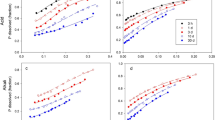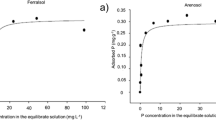Abstract
The agronomic effectiveness of unground North Carolina phosphate rock (PR) and partially acidulated phosphate rocks (PAPR) prepared by acidulation of the PR with 30%, 40% and 50% of the phosphoric acid needed for complete acidulation, was determined in a 4 year field experiment on permanent pastures. The soil developed from volcanic ash, and was highly P retentive. The rate of dissolution in soil of the PR component in PAPR and of PR applied directly was measured, together with bicarbonate extractable P. The priming effect of the monocalcium phosphate (MCP) component of PAPR on root growth was also investigated.
Pasture yields showed that even the 30% acidulated PAPR was as effective as fully acidulated triple superphosphate (TSP), mainly due to the high reactivity of the PR used. The 50% acidulated PAPR tended to be superior to TSP. Soluble P in PAPR caused a marked increase in root proliferation, and dry matter yields were greater than predicted from the amounts of MCP and PR in PAPR. Directly applied PR was inferior to TSP in years 1 and 2 but was equal in year 4. (There was no pasture response to application of P fertilizers in year 3.)
Dissolution rates of the PRs were determined applying a cubic model to PR dissolution data. The rate of dissolution increased with increasing acidulation and this is tentatively ascribed to increased root proliferation around PAPR granules and acidification of the clover rhizosphere during nitrogen fixation.
Similar content being viewed by others
References
AOAC (1980) Official methods of analysis. Ed. W Horwitz. (13th ed), Association of official Analytical Chemists, Washington DC, Sec 2.042
Basson WD (1976) Nitrogen and phosphorus determinations in animal feeds on a continuous flow system. Laboratory Practice 25: 763–765
Bolan NS, Hedley MJ, Harrison R and Braithwaite AC (1990) Influence of manufacturing variables on characteristics and the agronomic value of partially acidulated phosphate fertilizers. Fert Res 26: 119–138
Braithwaite AC (1987) Processing aspects of the production of partially acidulated phosphate rock fertilizers using phosphoric acid. Fert Res 13: 87–95
Charleston AG, Condron LM and Brown IWM (1989) The nature of the residual apatites remaining after partial acidulation of phosphate rocks with phosphoric and sulphuric acids. Fert Res 18: 257–274
Drew MC and Saker LR (1978) Nutrient supply and the growth of the seminal root system in barely III. Compensatory increases in growth of lateral roots, and in rates of phosphate uptake, in response to a localised supply of phosphate. J Exp Bot 29: 435–451
Golden DC, White RE, Tillman RW and Stewart RB (1991) Partially acidulated reactive phosphate rock (PAPR) fertilizer and its reactions in soil: I. Initial movement of dissolved ions and solubility of the phosphate rock residue. Fert Res 28: 281–293
Gregg PEH, Mackay AD, Currie LD and Syers JK (1988) Application strategies for Sechura phosphate rock use on permanent pasture. Fert Res 17: 219–234
Hagin J, Rajan SSS, Boyes MK and Upsdell M (1990) Partially acidulated phosphate rocks: phosphorus release characteristics. Fert Res 22: 109–117
Halder AK, Mishra AK, Bhattacharyya P and Chakrabartty PK (1990) Solubilization of rock phosphate by Rhizobium and Bradyrhizobium J Gen Appl Microbiol 36: 81–92
Hammond LL, Chien SH and Mokwunye AV (1986) Agronomic value of unacidulated and partially acidulated phosphates rocks indigenous to the tropics. Adv Agron 40: 89–140
Harrison R and Hedley MJ (1987) Phosphate rock dissolution during the manufacture and hydrolysis of partially acidulated phosphate rocks. In: White RE and Currie LD (eds) The Use of Reactive Phosphate Rocks and their derivatives as Fertilizers. Occasional Report No 1: p 3–10 Fertilizer and Lime Research Centre, Massey University, NZ
Haynes RJ (1983) Soil acidification induced by leguminous crops. Grass and Forage Sci 38: 1–11
Hollander M and Wolfe DA (1973) Nonparametric statistical methods. John Wiley and Sons: USA
Junge A and Werner W (1989) Investigations on interactions of phosphorus compounds in partially acidulated phosphate rock and fertilizer effectiveness. Fert Res 20: 129–134
Mokwunye A, Uzo and Chien SH (1980) Reactions of partially acidulated phosphate rock with soils from the Tropics. Soil Sci Soc Am J 44: 477–482
Olsen SR, Cole CW, Watanabe F and Dean LA (1954) Estimation of available phosphorus in soils by extraction with sodium bicarbonate. US Department of Agriculture circular 939
Ortlepp H and Wagner E (1968) Die teilaufgeschlossenen Phosphatdunger. Verein Dtsch Dunger-Fabik: Hamburg-Sasel
Panda N and Misra UK (1970) Use of partially acidulated rock phosphate as a possible means of minimising phosphate fixation in acid soils. Plant and Soil 33: 225–234
Perrott KW, Sarathchandra SU and Waller JE (1990) Seasonal storage and release of phosphorus and potassium by organic matter and the microbial biomass in a high-producing pastoral soil. Aust J Soil Res 28: 593–608
Rajan SSS (1983) Effect of sulphur content of phosphate rock/sulphur granules on the availability of phosphate to plants. Fert Res 4: 287–296
Rajan SSS (1985) Partial acidulation of an ‘unground’ phosphate rock. 1. Preparation and Characteristics. Fert Res 8: 147–155
Rajan SSS (1986) Partial acidulation of ‘unground’ phosphate rock. II Plant availability of phosphate. Fert Res 8: 219–229
Rajan SSS (1987) Partially acidulated phosphate rock as fertilizer and dissolution in soil of the residual rock phosphate. NZ J Exp Agric 15: 177–184
Rajan SSS (1987) Phosphate rock and phosphate rock/sulphur granules as phosphate fertilizers and their dissolution in soil. Fert Res 11: 43–60
Rajan SSS and Watkinson JH (1988) Measurement of rock phosphate dissolution in soil by the inorganic P fractionation method. Proc Aust Soc Soil Sci Conf. pp 113
Resseler H and Werner W (1989) Properties of unreacted rock residues in partially acidulated phosphate rocks affecting their reactivity. Fert Res 20: 135–142
Rixon AJ (1966) Soil fertility changes in a red-brown earth under irrigated pastures I. Changes in organic carbon, carbon/nitrogen ratio, cation exchange capacity and pH. Aust J Agric Res 17: 303–316
Roy NK, Mathus BS and Mishra B (1989) A study on partial acidulation and quality of rock phosphate as judged by lime and phosphate potentials. J Ind Soc Soil Sci 37: 388–390
Searle PL (1986) The measurement of soil cation exchange properties using the single extraction, silver thiourea method: An evaluation using a range of New Zealand soils. Aust J Soil Res 24: 193–200
Sinclair AG and Dyson CB (1988) An interim report on the MAF ‘National series’ forms of phosphate fertilizer trials: herbage dry matter production for growing seaons 1982/83 to 1986/87 inclusive. MAFTech, Wellington: New Zealand
Swart de PH and Diest van A (1987) The rock phosphate solubilising capacity ofPueraria javanica as affected by soil pH, superphosphate priming effect and symbiotic nitrogen fixation. Plant and Soil 100: 135–147
Swartzendruber D and Barber SA (1965) Dissolution of limestone particles in soil. Soil Sci 100: 287–291
Watkinson JH (1989) Measurement of the oxidation rate of elemental sulfur in soil. Aust J Soil Res 27: 365–375
Author information
Authors and Affiliations
Rights and permissions
About this article
Cite this article
Rajan, S.S.S., Watkinson, J.H. Unacidulated and Partially acidulated phosphate rock: Agronomic effectiveness and the rates of dissolution of phosphate rock. Fertilizer Research 33, 267–277 (1992). https://doi.org/10.1007/BF01050882
Received:
Accepted:
Issue Date:
DOI: https://doi.org/10.1007/BF01050882




